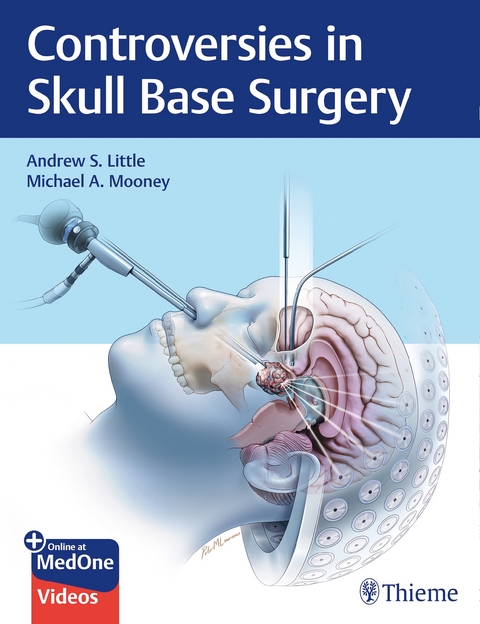
Controversies in Skull Base Surgery
Thieme (Verlag)
978-1-62623-953-1 (ISBN)
Advances in endoscopic, microsurgical, radiosurgical, and pharmacotherapeutic strategies have revolutionized the treatment of skull base pathologies. »Controversies in Skull Base Surgery«, edited by Andrew Little and Michael Mooney and authored by esteemed multidisciplinary contributors, focuses on management strategies and treatment options for a wide range of tumors affecting the skull base, while addressing the most urgent and challenging questions facing skull base surgeons today.
Throughout nine sections and 46 chapters, experts describe the treatment of neoplasms such as vestibular schwannoma, meningioma, pituitary adenoma, craniopharyngioma, chordoma, cranial nerve schwannoma, sinonasal malignancies, and others. In many chapters, authors provide instructional case studies and suggestions for future studies to help clarify areas of controversy. This textbook is unique in that it tackles problems typically minimized or ignored by other texts that impact a patient's quality of life and recovery.
Key Highlights:
- Reader-friendly tables feature concise summaries, author pearls, and levels of available evidence
- Pearls and insights on hotly debated issues such as the role of radiosurgery, surgery vs. medical management, radical resection vs. subtotal resection, and proton-beam vs. photon therapy for various pathologic conditions
- Controversies not frequently discussed in depth, including the use of lumbar drains, postoperative antibiotics, and cerebral revascularization in skull base surgery; multidisciplinary collaboration in endoscopic endonasal surgery; skull base reconstruction techniques; and the future of robotics in skull base surgery
This stellar resource will benefit all residents and advanced practice providers who evaluate and treat patients with skull base pathologies, including neurosurgeons, otolaryngologists, and radiation and medical oncologists.
This book includes complimentary access to a digital copy on https://medone.thieme.com.
Part I Vestibular Schwannoma
1 Controversies in the Natural History of Acoustic Neuromas
2 Controversies in Radiosurgery for Acoustic Neuromas: Single-Session Therapy versus Hypofractionated Therapy
3 Management of Residual Vestibular Schwannoma After Subtotal Resection: Observation, Repeat Surgery, or Radiosurgery?
4 Treatment Strategies for Small Intracanalicular Vestibular Schwannomas in Young Patients with Good Hearing
Part II Meningioma
5 Transcranial Approaches Are Preferred for Certain Tuberculum and Olfactory Groove Meningiomas
6 Endoscopic Endonasal Surgery Is the Best Treatment for Certain Anterior Fossa Skull Base Meningiomas
7 Controversies in the Management of Petroclival Meningiomas
8 Does Embolization Have a Role to Play in the Treatment of Skull Base Meningiomas?
9 The Role of Radiotherapy for Atypical and Anaplastic Meningiomas
10 Emerging Chemotherapy and Targeted Therapy for Aggressive Meningiomas
Part III Pituitary Adenoma
11 The Role of Transsphenoidal Surgery Following Nondiagnostic Inferior Petrosal Sinus Sampling in Cushing Syndrome
12 Pharmacotherapy Options After Failed Surgery for Cushing Disease
13 Primary Medical Therapy for Acromegaly, Ready for Prime Time?
14 The Role of Radiosurgery for Pituitary Adenomas
15 Exploration of the Cavernous Sinus Is Effective During Transsphenoidal Surgery for Pituitary Adenoma
16 Surgery versus Medical Management: First-Line Treatment for Pituitary Apoplexy
17 Alternative Treatment Strategies for Atypical and Aggressive Pituitary Adenomas
Part IV Craniopharyngioma
18 Controversies in Radical Resection versus Subtotal Resection with Radiation in Craniopharyngioma
19 The Role of Open and Endoscopic Approaches to Craniopharyngiomas
20 The Molecular Pathogenesis of Craniopharyngioma and Potential Therapeutic Targets
21 Resection versus Cyst Fenestration: The Best Treatment for Rathke Cleft Cysts
Part V Rathke Cleft Cyst and Other Sellar Lesions
22 Headache in Patients with Rathke Cleft Cysts
23 Rathke Cleft Cyst Surgery: Indications, Outcomes, and Complications
24 Controversies in the Management of Histiocytosis and Xanthogranulomas
25 Surgical Approach Selection for Skull Base Chordoma
Part VI Other Cranial Tumors
26 Chordoma Genetics and Tumor Phenotype Profiles
27 Surgery versus Radiation versus Observation: What Treatment Is Best for Skull Base Paraganglioma
28 Management of Chondrosarcoma of the Cranial Base
29 Natural History and Treatment Strategies for Posterior Fossa Epidermoids
30 Indications for and Outcomes of Radiosurgery in Trigeminal and Jugular Foramen Schwannomas
Part VII Cranial Nerve Schwannoma
31 Challenges of Applying Endoscopic Techniques for Cranial Nerve Schwannomas
32 Management of Cranial Nerve III, IV, and VI Schwannomas
33 Treatment of Facial Pain in Patients with Trigeminal Schwannoma
34 Induction Therapy for Esthesioneuroblastoma
Part VIII Sinonasal Malignancies
35 Surgical Approach for Esthesioneuroblastoma: Controversy in Approach Selection
36 What Is the Role of Surgery for Adenoid Cystic Carcinoma
37 Proton-Beam versus Photon Therapy for Sinonasal Malignancies: Pros and Cons of Each Method
38 Controversies in Skull Base Reconstruction Techniques
Part IX Surgical Approaches and Techniques
39 The Role of Lumbar Drains in Skull Base Surgery
40 The Role of Postoperative Antibiotics in Endoscopic Endonasal Surgery
41 Does Otorhinolaryngology Collaboration Improve Outcomes in Endonasal Skull Base Surgery?
42 Controversies in Outcome Measures of Skull Base Surgery
43 To Bypass or Not? The Role of Revascularization in Skull Base Surgery
44 Transcranial versus Endoscopic Repair of Lateral Sphenoid Recess Encephaloceles
45 Cranioplasty Techniques
46 The Future of Robotics in Skull Base Surgery
| Erscheinungsdatum | 29.03.2019 |
|---|---|
| Zusatzinfo | 99 Abb. |
| Verlagsort | New York |
| Sprache | englisch |
| Maße | 279 x 216 mm |
| Gewicht | 1272 g |
| Einbandart | kartoniert |
| Themenwelt | Medizinische Fachgebiete ► Chirurgie ► Ästhetische und Plastische Chirurgie |
| Medizinische Fachgebiete ► Chirurgie ► Neurochirurgie | |
| Medizin / Pharmazie ► Medizinische Fachgebiete ► HNO-Heilkunde | |
| ISBN-10 | 1-62623-953-3 / 1626239533 |
| ISBN-13 | 978-1-62623-953-1 / 9781626239531 |
| Zustand | Neuware |
| Informationen gemäß Produktsicherheitsverordnung (GPSR) | |
| Haben Sie eine Frage zum Produkt? |
aus dem Bereich


